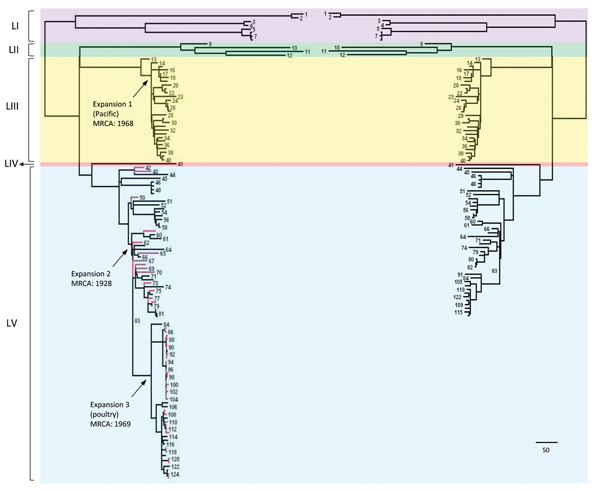Genomic Epidemiology of Salmonella enterica Serotype Enteritidis based on Population Structure of Prevalent Lineages
Xiangyu Deng

, Prerak T. Desai, Henk C. den Bakker, Matthew Mikoleit, Beth Tolar, Eija Trees, Rene S. Hendriksen, Jonathan G. Frye, Steffen Porwollik, Bart C. Weimer, Martin Wiedmann, George M. Weinstock, Patricia I. Fields
1, and Michael McClelland
1
Author affiliations: University of Georgia, Griffin, Georgia, USA (X. Deng); University of California Irvine, Irvine, California, USA (P.T. Desai, S. Porwollik, M. McClelland); Cornell University, Ithaca, New York, USA (H.C. den Bakker, M. Wiedmann); Centers for Disease Control and Prevention, Atlanta, Georgia, USA (M. Mikoleit, B. Tolar, E. Trees, P.I. Fields); Technical University of Denmark, Lyngby, Denmark (R.S. Hendriksen); US Department of Agriculture, Athens, Georgia, USA (J.G. Frye); University of California Davis, Davis, California, USA (B.C. Weimer); Washington University School of Medicine, St. Louis, Missouri, USA (G.M. Weinstock)
Main Article
Figure 1

Figure 1. Comparison of Salmonella enterica serotype Enteritidis phylogenies inferred from Illumina data and combined data of Illumina (San Diego, CA, USA) and Roche 454 (Indianapolis, IN, USA). The tree on the right incudes 80 Illumina sequenced isolates and the reference genome (PT4). The tree on the left includes both the 80 Illumina and the 44 454 sequenced isolates in addition to the reference. Isolates were numbered (online Technical Appendix Table 1, http://wwwnc.cdc.gov/EID/article/20/9/13-1095-Techapp1.pdf). Lineages I, II, III, IV, and V are highlighted in purple, green, yellow, red, and blue, respectively. Branches representing 454 sequenced isolates are labeled in red. Arrows on the left tree indicate the 3 serotype Nitra isolates. MRCA, most recent common ancestor. Scale bar indicates 10 single-nucleotide polymorphisms.
Main Article
Page created: August 13, 2014
Page updated: August 13, 2014
Page reviewed: August 13, 2014
The conclusions, findings, and opinions expressed by authors contributing to this journal do not necessarily reflect the official position of the U.S. Department of Health and Human Services, the Public Health Service, the Centers for Disease Control and Prevention, or the authors' affiliated institutions. Use of trade names is for identification only and does not imply endorsement by any of the groups named above.
